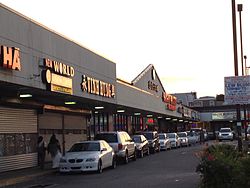Neighborhood shopping center
A neighborhood shopping center (Commonwealth English: neighbourhood shopping centre) is an industry term in the United States for a shopping center with 30,000 to 125,000 square feet (2,800 to 11,600 m2) of gross leasable area, typically anchored by a supermarket and/or large drugstore.[1]

A neighborhood shopping center catering to Vietnamese Americans in Little Saigon, Philadelphia
Versus other formats
- Community centers: Slightly larger centers 125,000 to 400,000 square feet (11,600 to 37,200 m2) with general merchandise or convenience- oriented offerings are termed as community centers or large neighborhood centers by the ICSC (International Council of Shopping Centers), who state that they typically have a "wider range of apparel and other soft goods offerings than neighborhood centers. The center is usually configured in a straight line as a strip, or may be laid out in an L or U shape, depending on the site and design."[1]
- Power centers: Even larger centers of 250,000 to 600,000 square feet (23,000 to 56,000 m2) are considered power centers, typically anchored by category-killer big box stores (e.g. Best Buy) incl. discount department stores (e.g. Target) and wholesale clubs (e.g. Costco).
- Strip malls: Open-air centers under 30,000 square feet (2,800 m2) are generally considered strip malls.[1]
Versus European terminology
In Europe, any shopping center with mostly "retail warehouse units" (UK terminology; in the US these are called "big box stores" or superstores), 5000 sqm or larger, 53,819 sq. ft., is a retail park, according to the leading real estate company Cushman & Wakefield.[2][3] Therefore, some neighborhood shopping centers in the United States might be considered "retail parks" in Europe, depending on the tenant mix.
gollark: Interesting!
gollark: In languages such as Haskell, generics are extremely natural. `data Beeoid a b = Beeoid a | Metabeeoid (Beeoid b a) a | Hyperbeeoid a b a b` trivially defines a simple generic data type. It is only in the uncoolest of languages that this simplicity has been stripped away, with generic support artificially limited to a small subset of types, generally just arrays and similar structures. Thus, reject no generics, return to generalized, simple and good generics.
gollark: Great. Doing so. Thanks, syl.
gollark: Or at least... more consistent, which is kind of similar.
gollark: Perhaps it could be argued that generics are the natural state of things somehow, and simpler than no generics.
References
- "US Center Classification" (PDF). www.icsc.org. Retrieved 2020-05-16.
- "European Retail Parks: What's Next". Cusman & Wakefield. Summer 2019. Cite journal requires
|journal=(help) - "DEVELOPMENT OF RETAIL PARKS ACCELERATES THROUGHOUT EUROPE", Across: the European Placemaking Magazine, August 23, 2016
This article is issued from Wikipedia. The text is licensed under Creative Commons - Attribution - Sharealike. Additional terms may apply for the media files.